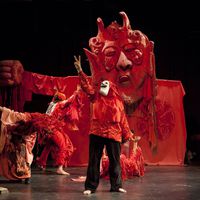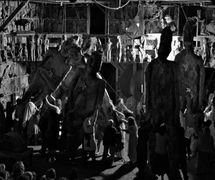American theater company using puppets of all sizes for the creation of political theatre, founded in 1963 by Peter Schumann. Bread and Puppet Theater was first based on the Lower East Side of New York. Peter Schumann was born in Lüben, Silesia, Germany, in 1934. Puppeteer Max Jacob was a family friend. During Schumann’s early years as an artist, he sculpted and danced; a major influence was the work of Merce Cunningham and John Cage. In 1961, Peter and his American-born wife Elka Scott Schumann came to the United States. Schumann became immersed in the avant-garde art and performance scene in New York City. His skills and interest in dance and sculpture were combined in puppetry, and his bread baking and distribution articulated a utilitarian function of art practice synthesized with daily life.
Schumann’s giant puppets, which became the signature of Bread and Puppet, first appeared in 1965 at political street parades in New York City, and increasingly became identified with the anti-Vietnam War movement. In 1966, Schumann created a mask play, Fire, which made a sensational impression at France’s 1968 Nancy Festival and earned Bread and Puppet an Off-Broadway Obie Award the same year. Other influential productions of this period include King Story (1963), Christmas Story (1963), A Man Says Goodbye to His Mother (1967), Grey Lady Cantata #1 (1968), and The Cry of the People for Meat (1969). By 1970, Schumann and his company had created over 60 works and attained international acclaim.
Residence in Vermont
Peter Schumann and his family moved to Vermont in 1970, and Bread and Puppet became the theater-in-residence at Goddard College’s Cate Farm. At Cate Farm, Schumann continued to create new indoor and outdoor shows, including Grey Lady Cantatas #2 and #3 (1971), The Birdcatcher in Hell (1971), That Simple Light May Rise from Complicated Darkness (1973), and The Stations of the Cross (1974). In 1970, inspired by the Vermont countryside, Schumann began to create giant outdoor spectacles of pageantry, sideshows, and circus acts, which he called Our Domestic Resurrection Circus. Live music for Bread and Puppet productions might include a Bach cantata, a plaintive folk violin, Early American “Sacred Harp” singing, homemade instruments, or raucous New Orleans-style jazz. In the mid-1970s, Schumann began to dance on stilts, a technique the company employed in numerous shows to follow.
In 1974, the Schumanns moved Bread and Puppet Theater to a farm in Glover, Vermont, which became the venue of the annual Domestic Resurrection Circus until 1998. With the puppeteers of his Glover company, Schumann created White Horse Butcher (1976), Joan of Arc (1977), The Ballad of Masaniello (1977), Ah! or the First Washerwoman Cantata (1979), Diagonal Man: Theory and Practice (1982), The Door (1984), The Uprising of the Beast (1990), Mr. Budhoo’s Letter of Resignation from the IMF (1996), Insurrection Mass with Funeral March for a Rotten Idea (2002), and dozens of other significant works performed in the Americas, Europe, and Asia. The Domestic Resurrection Circus became a venerable countercultural event, a free outdoor spectacle of sideshows, puppet circus, and pageant featuring hundreds of performers and giant puppets performing in a landscape of forests and fields, and providing unforgettable images for an ever-growing number of participants and spectators. Although the Domestic Resurrection Circus ceased in 1998, the theater continues to perform outdoor spectacles on weekends during the summer.
In 1976, The Bread and Puppet Museum was created in a 19th-century barn at the theater’s farm; it can be reached at 753 Heights Road, Glover, VT, 05839, USA.
International Recognition
Bread and Puppet has been featured at scores of international theatre festivals around the world. It performed Joan of Arc at the UNIMA 13th World Puppetry Festival in Washington, DC in 1980, and opened the first Henson International Festival of Puppet Theater in New York in 1992. Hundreds of puppeteers have been inspired by their work with Peter Schumann, including Amy Trompetter, Massimo Schuster, Paul Zaloom, Julie Taymor, John Bell (and Great Small Works), Sara Peattie, Clare Dolan, Stephen Kaplin, and Roman Paska. The Minneapolis (Minnesota) theatre company In the Heart of the Beast Puppet and Mask Theatre, founded in 1973, was inspired by director Sandy Spieler’s work with Schumann.
After 50 years, Bread and Puppet continues to make “Cheap Art and Political Theater” with indoor and outdoor puppet shows, parades, workshops, and exhibitions. It travels extensively in Western and Eastern Europe, North and South America, and in Asia. The work of Bread and Puppet Theater can be seen in such videos as Brother Bread, Sister Puppet (1993) and Ah! The Hopeful Pageantry of Bread and Puppet (2002).
Peter Schumann has been awarded Holland’s Erasmus Prize (1978), the Puppeteers of America President’s Award (1979), and is a UNIMA Member of Honour (1996). He is the author of numerous articles, manifestos, and books, including “The Radicality of the Puppet Theater” (1991), and “What, At the End of This Century, Is the Situation of Puppets and Performing Objects?” (2001). The Bread and Puppet Press, created by Elka Schumann, has printed hundreds of books, posters, pamphlets, and calendars.
Peter Schumann’s Bread and Puppet Theater is recognized as a major force in contemporary world theatre. His pageants with giant puppets and masks presented in the streets of New York City and the hills of Vermont created a radical redefinition of performance. The extraordinary range of Schumann’s work can be crude or sophisticated, charming or strident, and sources range from obscure religious symbols to current newspaper headlines. Bread and Puppet Theater began its work with a commitment to building community, questioning authority, celebrating humanity, exposing injustice, and working for world peace. Bread and Puppet Theater inspired a universe of puppet companies and independent artists around the world devoted to political activism and alternative theatre.
(See United States of America.)
Bibliography
- Bell, John. Landscape and Desire: Bread and Puppet Pageants in the 1990s. Glover: Bread and Puppet Press, 1997. [S]
- Brecht, Stefan. The Bread and Puppet Theater. 2 vols. London: Methuen Paperback, 1988.
- Dennison, George. An Existing Better World: Notes on the Bread and Puppet Theater. Brooklyn: Autonomedia, 2000. [S]
- Farber, Jeff, dir. Brother Bread, Sister Puppet. 1993. (DVD)
- Green, Susan, ed. Bread & Puppet: Stories of Struggle & Faith from Central America. Burlington: Green Valley Film and Art, 1985.[S]
- Halleck, DeeDee, dir. Ah! The Hopeful Pageantry of Bread and Puppet. 2002. (Video)
- Ilari-Defina, Mayumi Denise. Teatro politico e contestação no mundo globalizado: O Bread and Puppet Theater na sociedade de consumo [Political and Protest Theatre in the Globalized World: The Bread and Puppet Theatre in a Consumer Society]. São Paulo, 2010.[S]
- Kourilsky, Françoise. Le Bread and Puppet Theatre. Lausanne: La Cité, 1971.[S]
- Mancini, Andrea, ed. Bread & Puppet: La cattedrale de cartapesta [Bread & Puppet: The Cathedral of Papier-mâché]. Pisa: Titivillus, 2002.[S]
- Schumann, Peter. “The Radicality of the Puppet Theatre”. TDR 35.4, Winter 1991, pp. 75-83.
- Schumann, Peter. “What, At the End of This Century, Is the Situation of Puppets and Performing Objects?” Puppets, Masks and Performing Objects. Ed. John Bell. Cambridge (MA): MIT Press, 2001
- Secci, Sergio. Il teatro dei sogni materializzati: Storia e mito del Bread and Puppet Theatre [The Theatre of Materialized Dreams: History and Myth of the Bread and Puppet Theater]. Firenze: La Casa Usher, 1986.[S]
- Simon, Ron, and Marc Estrin. Rehearsing with Gods: Photographs and Essays on Bread & Puppet Theater. White River Junction: Chelsea Green, 2004.[S]












